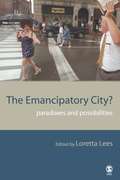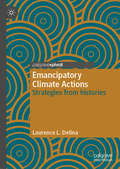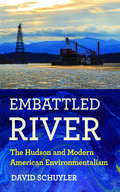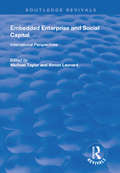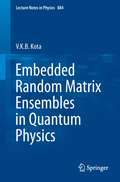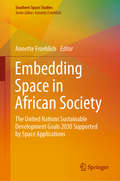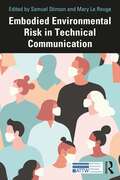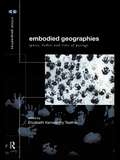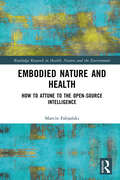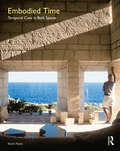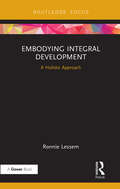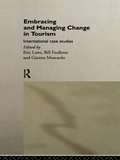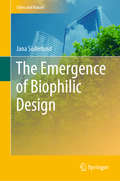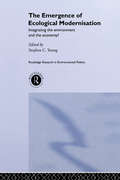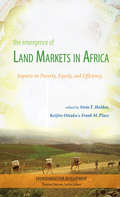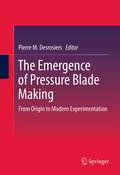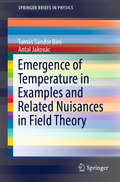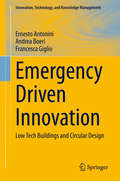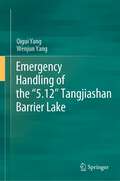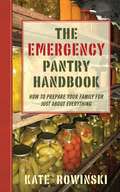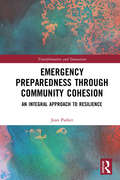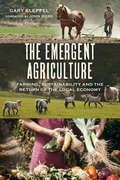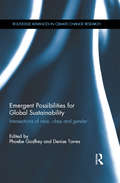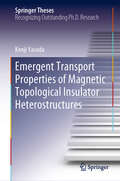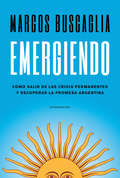- Table View
- List View
The Emancipatory City?: Paradoxes and Possibilities
by Loretta Lees'The Emancipatory City is a wonderful addition to a growing literature on the public culture of the city. In these spaces, tolerance and intolerance, difference and indifference, transgressions, resistances, and playful spontaneity erupt to give texture to urban life. The book broadens our gaze and deepens our understanding of how cities enable people to express themselves and be free' - Robert A Beauregard, New School University, New York Who are cities for? What kinds of societies might they most democratically embody? And, how can cities be emancipatory sites? The ambivalent status of urban space in terms of emancipation, democratisation, justice and citizenship is central to recent work in urban geography, `new' cultural geography, critical geography and postmodern planning, as well as literature on urban social justice, public space and the politics of identity. Seeking alternative and progressive visions of the emancipatory city through an exploration of the tensions and possibilities between the freedoms and constraints offered by the city, the authors of The Emancipatory City? build on this wealth of current perspectives to present an critical analysis of urban experience.
Emancipatory Climate Actions: Strategies from histories
by Laurence L. DelinaThis book calls for a collective strengthening of the progressive dimension of climate action in the face of continued myopic governmental response. Delina argues that consent must be revoked and power realigned to avoid suffering the consequences of unabated climate change. He looks back at the mechanisms that make previous social mobilizations successful to design strategies that would advance a new hegemonic agenda. This new agenda calls for the culturing of contemporary human societies towards a hegemony characterized by just emancipations and sustainable transformations. Mining select histories from India, the United States, the Philippines, and Burma, the book explores topics including visioning and identity building; framing; triggering pressure; boosting publicity; and diversifying networks as strategic tools to the repertoires of climate action groups, organizations, and institutions. It will be of great value to academics and practitioners, as well as to anyone interested in how to actively combat climate change.
Embattled River: The Hudson and Modern American Environmentalism
by David SchuylerIn Embattled River, David Schuyler describes the efforts to reverse the pollution and bleak future of the Hudson River that became evident in the 1950s. Through his investigative narrative, Schuyler uncovers the critical role of this iconic American waterway in the emergence of modern environmentalism in the United States.Writing fifty-five years after Consolidated Edison announced plans to construct a pumped storage power plant at Storm King Mountain, Schuyler recounts how a loose coalition of activists took on corporate capitalism and defended the river. As Schuyler shows, the environmental victories on the Hudson had broad impact. In the state at the heart of the story, the immediate result was the creation in 1970 of the New York State Department of Environmental Conservation to monitor, investigate, and litigate cases of pollution. At the national level, the environmental ferment in the Hudson Valley that Schuyler so richly describes contributed directly to the creation of the Environmental Protection Agency in 1970, the passage of the Clean Water Act in 1972, and the creation of the Superfund in 1980 to fund the cleanup of toxic-dumping sites.With these legal and regulatory means, the contest between environmental advocates and corporate power has continued well into the twenty-first century. Indeed, as Embattled River shows, the past is prologue. The struggle to control the uses and maintain the ecological health of the Hudson River persists and the stories of the pioneering advocates told by Schuyler provide lessons, reminders, and inspiration for today's activists.
Embedded Enterprise and Social Capital: International Perspectives (Routledge Revivals)
by Simon LeonardThis title was first published in 2002. The concept of embeddedness refers to the social construction of inter-firm relationships and the enmeshing of economic relationships within broader social structures and relationships in particular places. Previous research has suggested embedding is the best way to generate local growth and social capital and has focused on SMEs in Europe and North America, although the existing model is being more widely adopted now. This volume is the first to examine the complex processes of embedding in this wider context. Bringing together a broad range of case studies from the developed and developing world which address the nature of embeddedness from various perspectives, it not only questions the universality of the current model and the policy initiatives it has spawned but also provides a much wider understanding of embeddedness . It does so by discussing the social dimensions more fully and by throwing light on the spatial and temporal ambiguity of the concept and its inadequate treatment of power.
Embedded Random Matrix Ensembles in Quantum Physics
by V.K.B. KotaAlthough used with increasing frequency in many branches of physics, random matrix ensembles are not always sufficiently specific to account for important features of the physical system at hand. One refinement which retains the basic stochastic approach but allows for such features consists in the use of embedded ensembles. The present text is an exhaustive introduction to and survey of this important field. Starting with an easy-to-read introduction to general random matrix theory, the text then develops the necessary concepts from the beginning, accompanying the reader to the frontiers of present-day research. With some notable exceptions, to date these ensembles have primarily been applied in nuclear spectroscopy. A characteristic example is the use of a random two-body interaction in the framework of the nuclear shell model. Yet, topics in atomic physics, mesoscopic physics, quantum information science and statistical mechanics of isolated finite quantum systems can also be addressed using these ensembles. This book addresses graduate students and researchers with an interest in applications of random matrix theory to the modeling of more complex physical systems and interactions, with applications such as statistical spectroscopy in mind.
Embedding Space in African Society: The United Nations Sustainable Development Goals 2030 Supported by Space Applications (Southern Space Studies)
by Annette FroehlichThis book provides a detailed insight into how space and its applications are embedded, and can be further embedded, into African society in support of the SDGs, while taking into account the specific features, needs, and diversity of that society.Contributions drawn from across the continent and further afield provide analyses of the particular social situations in a variety of different African countries and regions, and highlight areas where space applications support the SDGs, and where they can further do so. The chapters cover a wide array of relevant and timely topics including basic needs like water quality, education, and capacity building, as well as financial, security, and legal aspects, together with facets of space technologies and infrastructure in Africa. Embedding Space in African Society will be of great interest to students and professionals in sustainable development, governance, and space studies.
Embodied Environmental Risk in Technical Communication: Problems and Solutions Toward Social Sustainability (ATTW Series in Technical and Professional Communication)
by Samuel StinsonThis collection calls for improved technical communication for the public through an embodied, situated understanding of environmental risk that promotes social justice. In addition to providing a series of chapters about recent issues on risk communication, this volume offers a diverse look at methodological practices for students, researchers, and practitioners looking to address embodied aspects of crisis and risk that incorporate UX, storytelling, and dynamic text. It includes chapters that bring embodiment to the forefront of risk communication, highlighting the cycle of content creation, dissemination, public response and decision making, continuing iterations of educational efforts, and recovery, toward increasing adaptive capacity as a whole. In addition, this work directs necessary attention to overcoming perceptual difficulties, memory lapses, definitional differences, access issues, and pedagogical problems in the communication of risks to diverse publics. This collection is essential reading for scholars and can be used as a supplemental text or casebook for courses in technical communication, environmental communication, risk and crisis communication, science communication, and public health.
Embodied Geographies (Critical Geographies)
by Elizabeth Kenworthy TeatherEmbodied Geographies provides a comprehensive account of different types of life crises which develop our identities and affect how we live our lives. Chapters focus on:* pregnancy, childbirth, teenagers and parenthood* migration* the threat and reality of violence* illness and disability* bereavement, the ensuing family responsibilities and death itself.It includes case studies from the UK, Australia, New Zealand, Singapore, Hong Kong, Canada and the USA.
Embodied Nature and Health: How to Attune to the Open-source Intelligence (Routledge Research in Health, Nature and the Environment)
by Marcin FabjańskiThis book describes how, as a species our survival and capacity to flourish depends on realizing the intimate relationship of humans with nature through active, embodied participation with nature. Living within the physicality of the planet is not a limitation, rather it is our liberation. Full realization of the consequences of this relationship, through embodied action, can liberate us from ego-dependence and transform us into a community of interdependent and flourishing beings. Embodied Nature and Health: How to Attune to the Open-source Intelligence describes a systems analysis of presence-centered cultivation of well-being through particular ways of being physically and mentally active in relation to nature that aims at helping the individual attune to natures’ rhythms. The systems analysis proposes the hypothesis of the Open-source Intelligence: an intelligence which originates from the placement of individual organisms in the tissue and the process of life. This framework draws upon and integrates contemporary research into the human–nature relationship and human well-being, and ancient philosophies that were developed prior to the Cartesian gap between the mind and the body, as well as using an auto-ethnographic approach dervied from the experience of the author. The proposed system highlights a practical approach to well-being, based on research into human attention and its effective usage in daily life. The book outlines a methodology that can be used in schools, as a basis of training in sports, as well as in the field of self-development, and highlights the necessity to develop a new, non-abusive relationship with the natural environment. This novel, multi-discipline, first-of-its-kind research book will be of strong interest to experts and academics in the fields of physical activity, education, ecology, and philosophy.
Embodied Time: Temporal Cues in Built Spaces
by Kevin NuteThe word time occurs more than seven times as often as space in written English, yet in the design of the indoor environments where we now spend most of our lives these priorities are typically reversed, with time often being little more than an afterthought. Embodied Time endeavors to correct that imbalance by demonstrating how built environments can be designed to evoke positive recollections of the past, interactions with the present, and anticipations of the future.
Embodying Integral Development: A Holistic Approach (Transformation and Innovation)
by Ronnie LessemIn this fourth and final volume of the CARE-ing for Integral Development series, Ronnie Lessem integrates all that has come before in terms of: Community activation; Awakening integral consciousness; and institutionalized Research. Here he focuses on individual and community development alongside that of the organization or society, and sets it in the context of an integral economy. The four critical success factors identified in recognizing and releasing integral development aligned with CARE are: GROUNDING – linking up with and building upon existing local and global movements for socio-economic development; EMERGENCE – maintaining interconnected focus; NAVIGATING – locating and developing GENE-ius in a particular community/society; EFFECTING – committing to resolving an issue and identifying the most fertile development path. Embodying Integral Development offers a comprehensive system of accreditation. Supported by examples and illustrations of CARE, this book makes a case for Integral Development as a whole. It argues that it is a qualitative means of self-assessment rather than a quantitative one, focused on engagement, immersion and interpretation, as well as evaluation, rather than empirical verification.
Embracing and Managing Change in Tourism: International Case Studies
by Eric Laws Bill Faulkner Gianna MoscardoEmbracing and Managing Change in Tourism examines management responses to the major changes taking place in international tourism and considers tourism itself as an agent of change. Including twenty-two detailed case studies from around the world this book explores two key principles. Firstly that change is enevitable and, if effectively managed, has the potential to benefit all those living in, working in and visiting the destination. Secondly, that there are no universal prescriptions for the effective management of change in tourism, since each destination has distinguishing characteristics and the nature of the problems facing it change over time.
The Emergence of Biophilic Design (Cities and Nature)
by Jana SöderlundThis book addresses the emergence of biophilic design, a form of design that looks at people’s intrinsic connection with nature. There is no denying that biophilic design is rapidly expanding globally as an effective response to pressing issues in urban areas and built environments. From being a term few had heard of in 2012, when the author’s research began, to one that is currently trending in a broad range of disciplines, the story of its emergence has never been properly told. The story of the emergence of biophilic design is the story of a social movement and how a gathering of people with a common interest and passion can spark a global trend. The book and the stories within are not only engaging but also informative and educational, offering readers an in-depth understanding of what biophilic design is all about, and how to promote its implementation in their own built environment. Hopefully, they will inspire people to act, to campaign and to implement initiatives in their urban environment, with the confidence that they are capable of making a difference. The author spent three years researching the emergence of biophilic design, and why and how it was driven by certain people who championed the concept. Part of the author’s research involved a three-month tour of ten North American cities, during which she interviewed 26 key players. These people ranged from community leaders, landscape architects, and academics, to the CEOs of NGOs and government leaders. The result is a collection of stories that illustrate the evolution of biophilic design, and how it was frequently born from a passion for, belief in and love of nature, as well as a response to an urban crisis.
The Emergence of Ecological Modernisation: Integrating the Environment and the Economy? (Environmental Politics #1)
by Stephen C. YoungThe Emergence of Ecological Modernisation offers a wealth of empirical research material from an international perspective, bringing together previously scattered sources for the first time. It addresses a series of theoretical issues that are of key contemporary relevance, such as the relationship between ecological modernisation and sustainable development; strategies for promoting ecological modernisation, and the extent to which it is possible to 'green' contemporary capitalism.
The Emergence of Land Markets in Africa: Impacts on Poverty, Equity, and Efficiency (Environment for Development)
by Keijiro Otsuka Stein T. Holden Frank M. PlaceThis book is the first systematic attempt to address emerging land markets and their implications for poverty, equity, and efficiency across a number of African countries. The high incidence of poverty and the need for increased agricultural productivity remain acute in rural areas of sub-Saharan Africa, where a lack of secure land rights and a growing scarcity of land relative to the size of the population are becoming increasingly critical issues. Indeed, land issues in the region are high on the international policy agenda. Yet our knowledge about land tenure security and other rural factor markets (such as labor, oxen, manure, purchased inputs, and credit) is far from adequate to formulate sensible policies. The case studies in the book show that, while land markets and especially informal markets have been rapidly emerging in densely populated parts of Africa - and have generally been to the benefit of the poor--their functions remain imperfect. This is due to policy-induced tenure insecurity and the fragmentation of agricultural land. Applying rigorous quantitative analyses, the book provides a basis for taking into account the role of land markets in national land policies. All too often, the authors argue, land policies have been extreme, either prohibiting all land transactions or giving unrestricted freehold rights to a small elite at the expense of the poor. From the long experience in Asia, it is known that such policies are detrimental to both production efficiency and equity of land use. The authors argue that future policies in Africa should work with the markets. Regulations should be imposed only with careful testing that they are having the intended effects. The Emergence of Land Markets in Africa is a resource for teaching in developed and developing countries, as it provides both comprehensive reviews of the literature and detailed case studies. It is intended to facilitate the dialogue between researchers and policymakers, as well as inspire researchers to go further in their investigations and build an even stronger basis for good policies. The Emergence of Land Markets in Africa is the first publication in the new Environment for Development (EfD) book series. EfD books focus on research and applications in environmental and natural resource economics as they are relevant to poverty reduction and environmental problems in developing countries. The EfD book series is part of the EfD initiative. (www.environmentfordevelopment.org)
The Emergence of Pressure Blade Making
by Pierre M. DesrosiersHuman development is a long and steady process that began with stone tool making. Because of this skill, humans were able to adapt to climate changes, discover new territories, and invent new technologies. "Pressure knapping" is the common term for one method of creating stone tools, where a larger device or blade specifically made for this purpose is use to press out the stone tool. Pressure knapping was invented in different locations and at different points in time, representing the adoption of the Neolithic way of life in the Old world. Recent research on pressure knapping has led for the first time to a global thesis on this technique. The contributors to this seminal work combine research findings on pressure knapping from different cultures around the globe to develope a cohesive theory. This contributions to this volume represents a significant development to research on pressure knapping, as well as the field of lithic studies in general. This work will be an important reference for anyone studying the Paleolithic, Mesolithic, and Neolithic periods, lithic studies, technologies, and more generally, cultural transmission.
Emergence of Temperature in Examples and Related Nuisances in Field Theory (SpringerBriefs in Physics)
by Antal Jakovác Tamás Sándor BiróField theory, relying on the concept of continuous space and time while confronted with the quantum physical nature of observable quantities, still has some fundamental challenges to face. One such challenge is to understand the emergence of complexity in the behavior of interacting elementary fields, including among other things nontrivial phase structures of elementary matter at high energy density or an atypical emergence of statistical properties, e.g., when an apparent temperature is proportional to a constant acceleration in a homogeneous gravitational field. Most modern textbooks on thermal field theory are mainly concerned with how the field theory formalism should be used if a finite temperature is given. In contrast, this short primer explores how the phenomenon of temperature emerges physically for elementary fields - inquiring about the underlying kinetic field theory and the way energy fluctuations and other noise should be handled - and it investigates whether and how this harmonizes with traditional field theory concepts like spectral evolution, the Keldysh formalism, and phase transitions.
Emergency Driven Innovation: Low Tech Buildings and Circular Design (Innovation, Technology, and Knowledge Management)
by Ernesto Antonini Andrea Boeri Francesca GiglioThis book explores the relationship between the circular economy and the building technologies within the quintuple helix innovation model. The main question the book answers is whether and how the conversion of sustainable construction processes can be a powerful engine of innovation for the industry. The post-disaster settlements and temporary shelters are assumed as examples of what can be defined as circular buildings in regards to the technical arrangements and features, material and process reversibility, as the social and participative dimensions.Several cases of these interventions are documented and classified by three thematic axes: design, building and living. This highlighted new trajectories for innovation in building technology, consistent with the social, economic and productive dynamics that no longer allows for growing performance by increasing the resource demand. A theoretic framework is traced supporting this vision, which shows how the low technologies can respond to the transition of the economic model from linear to circular. Within this trajectory, the low-tech design for remanufacturing represents a reference framework and a promising tool applicable to the building processes.The enabling technologies and new paradigms for the transition to circular economy emerging from the European research scenario are also mapped, outlining z`the possible future developments in line with open technical and societal challenges.
Emergency Handling of the “5.12” Tangjiashan Barrier Lake
by Qigui Yang Wenjun YangThis book introduces emergency management of barrier lakes systematically,including theories and practices, risk assessment under extremely high-riskconditions, evolution of outburst floods, analysis of anti-impact stability, andemergency management technology and assessment of risk elimination effect.It takes the Tangjiashan barrier lake as a successful case study toillustrate effective treatment of barrier lake with high risks, poor environmentalconditions, extremely urgent rescue time and high disposal difficulties. Itretains a large number of images and data of great research value for the lakerisk assessment and building technological emergency system. It provides areliable reference for the government, scientific researchers and survey anddesign team to deal with the sudden natural disaster in barrier lakes,especially caused by huge earthquake.
The Emergency Pantry Handbook: How to Prepare Your Family for Just about Everything
by Kate Rowinski Jim RowinskiIn today’s world, anything can happen—medical emergencies, power outages, natural disasters. In less time than it takes to sign off on an insurance form, the world as we know it can be brought to a standstill. There can be no question: It’s best to be prepared. The Emergency Pantry Handbook by cooking expert and readiness enthusiast Kate Rowinski offers tips, techniques, and advice on how to keep your family safe, well-fed, and fully supplied in the event of any crisis. With simple instructions, Rowinski demonstrates how to create an emergency strategy; how to protect your house, documents, and keepsakes; and how to prepare for specific disasters. Offering a unique twist on preparation handbooks, Rowinski focuses on food storage and cooking—put simply, how to plan nutritional emergency meals and avoid “making due” on canned meats and chocolate bars. The Emergency Pantry Handbook details:· Storage techniques · Personalizing your food plan · Stockpiling, shelf life, and rotation · Pickling, canning, sprouting, and drying · Making delicious dinners out of your storage pantry Whether a disaster lasts for twenty-four hours or twenty-four weeks, The Emergency Pantry Handbook is the ultimate guide to keeping your family eating healthily and maintaining proper nutrition, even in the worst of circumstances.
Emergency Preparedness through Community Cohesion: An Integral Approach to Resilience (Transformation and Innovation)
by Jean ParkerThis book is a revision of the author’s original doctoral thesis on emergency preparedness through community radio in North Indian villages into a widening array of possible reapplications in other community development fields. The author expands on the process of transforming emergency preparedness education through community media in rural North India and applies this to the development of community-prosperity, defined simply as human and planetary well-being, anywhere in the world. A new theoretical framework is presented which combines the pivotal Integral Worlds Approach developed by Lessem and Schieffer with Critical Theory, thus exploring a new way to envision and implement social change, leading to innovation and social transformation. This book introduces the term "constructive resilience," which is a type of community-building that occurs alongside dominant societal structures that are either oppressive or ineffective. An evolving field of study and practice, it is emerging from the work of academics and community-builders who are members of the Bahá’í Faith. Bahá’í "consultation," a process of inquiry and decision-making, is offered as a systematic and effective method of defining problems and enacting solutions and is examined in the context of emergency preparedness education and local capacity-building. With its integral development approach, its unique combination of themes and theoretical components, and integration with the Bahá’í Faith, as well as its interdisciplinary nature, this book will be invaluable reading for researchers in many fields. It will be of particular interest in university-based training programs in disaster management and the various disciplines of international community development, as well as practitioners in the areas of micro enterprise, disaster management, community development, rural communications, rural economics and emergency preparedness education.
The Emergent Agriculture
by Gary Kleppel John IkerdLong embraced by corporations who are driven only by the desire for profit, industrial agriculture wastes precious resources and spews millions of tons of greenhouse gases into the atmosphere each year, exacerbating climate change and threatening the very earth and water on which we depend. However, this dominant system, from which Americans obtain most of their food, is being slowly supplanted by a new paradigm.The Emergent Agriculture is a collection of fourteen thematic essays on sustainability viewed through the lens of farming. Arguing that industrial food production is incompatible with the realities of nature, science, and ethics, this lyrical narrative makes the case for a locally based food system which is: Stable in the face of economic uncertainty Resilient in the face of environmental variability Grounded in stewardship of the land, on attaching value to food and the craft involved in producing it, and on respecting the dignity of farmers, consumer,s and livestockA revolution in food production is underway. Written from the vantage point of an ecologist who is also a farmer, The Emergent Agriculture is essential reading for anyone interested in food security and the potential for growing local economies. Food for thought about the future of food.Gary Kleppel is a professor of biology at the SUNY Albany, where he focuses on sustainable agriculture, conservation-based grazing, and the ecology of human-dominated landscapes. He and his wife Pam are owners of Longfield Farm, where they produce grass-fed lamb, wool, free range chickens and eggs, and artisanal breads.
Emergent Possibilities for Global Sustainability: Intersections of race, class and gender (Routledge Advances in Climate Change Research)
by Phoebe Godfrey Denise TorresIt must be acknowledged that any solutions to anthropogenic Global Climate Change (GCC) are interdependent and ultimately inseparable from both its causes and consequences. As a result, limited analyses must be abandoned in favour of intersectional theories and practices. Emergent Possibilities for Global Sustainability is an interdisciplinary collection which addresses global climate change and sustainability by engaging with the issues of race, gender, and class through an intersectional lens. The book challenges readers to foster new theoretical and practical linkages and to think beyond the traditional, and oftentimes reductionist, environmental science frame by examining issues within their turbulent political, cultural and personal landscapes. Through a variety of media and writing styles, this collection is unique in its presentation of a complex and integrated analysis of global climate change and its implications. Its companion book, Systemic Crises of Global Climate Change, addresses the social and ecological urgency surrounding climate change and the need to use intersectionality in both theory and practice. This book is a valuable resource for academics, researchers and both undergraduate and post-graduate students in the areas of Environmental Studies, Climate Change, Gender Studies and International studies as well as those seeking a more intersectional analysis of GCC.
Emergent Transport Properties of Magnetic Topological Insulator Heterostructures (Springer Theses)
by Kenji YasudaThis book reveals unique transport phenomena and functionalities in topological insulators coupled with magnetism and superconductivity. Topological insulators are a recently discovered class of materials that possess a spin-momentum-locked surface state. Their exotic spin texture makes them an exciting platform for investigating emergent phenomena, especially when coupled with magnetism or superconductivity. Focusing on the strong correlation between electricity and magnetism in magnetic topological insulators, the author presents original findings on current-direction-dependent nonreciprocal resistance, current-induced magnetization reversal and chiral edge conduction at the domain wall. In addition, he demonstrates how the coupling between superconductivity and topological surface state leads to substantial nonreciprocal resistance. The author also elucidates the origins of these phenomena and deepens readers’ understanding of the topologically nontrivial electronic state. The book includes several works which are published in top journals and were selected for the President’s Award by the University of Tokyo and for the Ikushi Prize, awarded to distinguished Ph.D. students in Japan.
Emergiendo: Cómo salir de las crisis permanentes y recuperar la promesa argentina
by Marcos BuscagliaMarcos Buscaglia analiza en detalle la peor crisis de la historia argentina (2018-2020) y propone un conjunto articulado y sólido de reformas para que el país encuentre su rumbo y comience a emerger del subdesarrollo dando lugar a una nueva república, superadora de la conservadora y de la peronista. La Argentina atraviesa el peor momento de su historia al tiempo que los argentinos, que parecemos capaces de naturalizarlo todo, sin objetivos ni aspiraciones comunes, empezamos a desdibujar nuestra identidad como sociedad. Marcos Buscaglia describe aquí, con detalle y profundidad inéditos, la crisis 2018-2020, pero va mucho más allá: presenta una visión, un camino para empezar a emerger. La salida tiene que ver con la economía y con la política, claro, pero también con la ciudadanía y la cultura porque, en última instancia, de lo que se trata es de valores. Poco piadoso y preciso en el reconocimiento de nuestras inconsistencias, valiente y sólido en el enunciado de las reformas necesarias, entusiasta y esperanzado en el potencial argentino, este libro propone la construcción de una nueva república, superadora tanto de la conservadora como de la peronista. El mensaje es claro: con vocación de futuro y voluntad de éxito, si los argentinos nos ponemos de acuerdo sobre el rumbo, no habrá obstáculo difícil de sortear. Porque no podemos permitir que nos gane el caos, conforme empecemos a andar, iremos dejando en el pasado nuestra historia de desencuentro y fracaso recurrentes. Entonces sí, finalmente, estaremos emergiendo.
